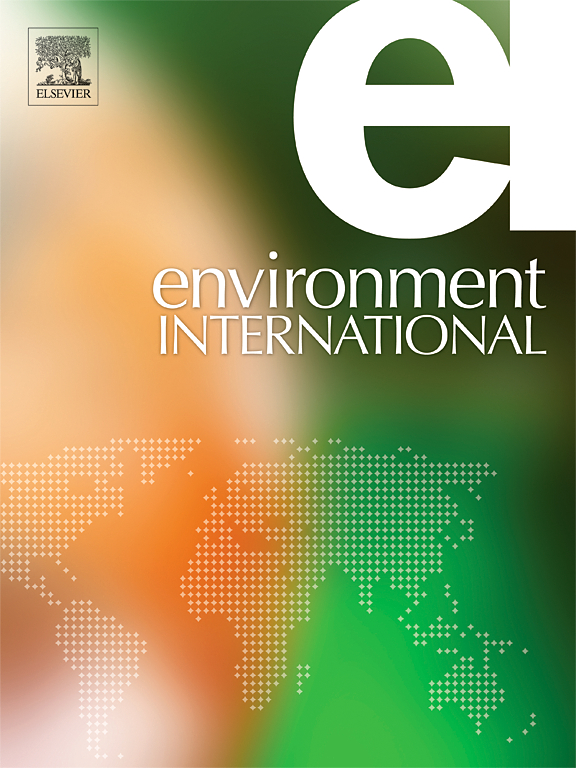Preconception, prenatal and early childhood exposure to green space and risk of neurodevelopmental delays: a national cohort study among Medicaid enrollees
IF 10.3
1区 环境科学与生态学
Q1 ENVIRONMENTAL SCIENCES
引用次数: 0
Abstract
Background
Exposure to green space is associated with children’s mental health, but its impact on neurodevelopment has been underexplored, especially in socioeconomically disadvantaged populations. This study examined the link between exposure to green space before, during, and after pregnancy and neurodevelopmental delays in children enrolled in Medicaid.
Methods
This cohort study of 1,841,915 mother–child pairs used data from the Medicaid Analytic Extract (MAX) from 2001 to 2014, with up to 14 years of follow-up. The population of pregnant women enrolled in Medicaid is characterized by younger age, racial and ethnic diversity, lower income levels, and includes individuals with disabilities. Green space exposure was measured using the Normalized Difference Vegetation Index (NDVI) at the maternal residential zip code level. We examined exposure to green space during the preconception, prenatal, and postnatal periods to capture critical developmental windows both separately and with mutual adjustment. Neurodevelopmental outcomes were identified using validated algorithms and included autism spectrum disorder (ASD), attention-deficit/hyperactivity disorder (ADHD), learning disabilities, speech and language disorders, coordination disorders, intellectual disabilities, and behavioral disorders. We applied a stratified Cox model accounting for individual and area-level confounders and examined effect measure modification by urbanicity, child’s race/ethnicity, and sex.
Findings
The study found protective associations between green space exposure and most neurodevelopmental disorders. The strongest associations were seen for preconception exposure and intellectual disability (HR 0.66 [95 % CI: 0.48–0.95]), pregnancy exposure and ASD (HR 0.83 [95 % CI: 0.73–0.95]), and postnatal exposure for learning difficulties (HR 0.81 [95 % CI: 0.68–0.97]) per interquartile range (IQR = 0.12) increase in NDVI. The protective effects were stronger for Black/Hispanic children and for those living in urban areas.
Interpretation
Green space exposure could benefit the children’s neurodevelopment, with more significant benefits for the Black and Hispanic populations.
Funding
National Institute of Environmental Health Sciences R01-ES034038.
孕前、产前和儿童早期接触绿地与神经发育迟缓的风险:一项针对医疗补助计划参保者的国家队列研究
接触绿色空间与儿童心理健康有关,但其对神经发育的影响尚未得到充分探讨,特别是在社会经济弱势群体中。这项研究调查了参加医疗补助计划的儿童在怀孕前、怀孕期间和怀孕后接触绿地与神经发育迟缓之间的联系。方法本队列研究使用2001年至2014年医疗补助分析提取(MAX)的数据,对1,841,915对母子进行了长达14 年的随访。参加医疗补助计划的孕妇的特点是年龄更年轻,种族和民族多样性,收入水平较低,包括残疾人。利用归一化植被指数(NDVI)在产妇居住邮编水平上测量绿地暴露。我们研究了在孕前、产前和产后暴露于绿色空间的情况,以分别捕捉和相互调节的关键发育窗口。使用经过验证的算法确定神经发育结局,包括自闭症谱系障碍(ASD)、注意缺陷/多动障碍(ADHD)、学习障碍、言语和语言障碍、协调障碍、智力残疾和行为障碍。我们采用了考虑个体和区域混杂因素的分层Cox模型,并检查了城市化、儿童种族/民族和性别对效应测量的影响。研究发现,接触绿色空间与大多数神经发育障碍之间存在保护性联系。产前暴露与智力残疾(HR 0.66[95 % CI: 0.48-0.95])、妊娠暴露与ASD (HR 0.83[95 % CI: 0.73-0.95])以及产后暴露与学习困难(HR 0.81[95 % CI: 0.68-0.97])每四分位数范围(IQR = 0.12)NDVI增加的相关性最强。对黑人/西班牙裔儿童和生活在城市地区的儿童的保护作用更强。接触绿色空间有利于儿童的神经发育,对黑人和西班牙裔人群有更显著的好处。国家环境健康科学研究所R01-ES034038。
本文章由计算机程序翻译,如有差异,请以英文原文为准。
求助全文
约1分钟内获得全文
求助全文
来源期刊

Environment International
环境科学-环境科学
CiteScore
21.90
自引率
3.40%
发文量
734
审稿时长
2.8 months
期刊介绍:
Environmental Health publishes manuscripts focusing on critical aspects of environmental and occupational medicine, including studies in toxicology and epidemiology, to illuminate the human health implications of exposure to environmental hazards. The journal adopts an open-access model and practices open peer review.
It caters to scientists and practitioners across all environmental science domains, directly or indirectly impacting human health and well-being. With a commitment to enhancing the prevention of environmentally-related health risks, Environmental Health serves as a public health journal for the community and scientists engaged in matters of public health significance concerning the environment.
 求助内容:
求助内容: 应助结果提醒方式:
应助结果提醒方式:


